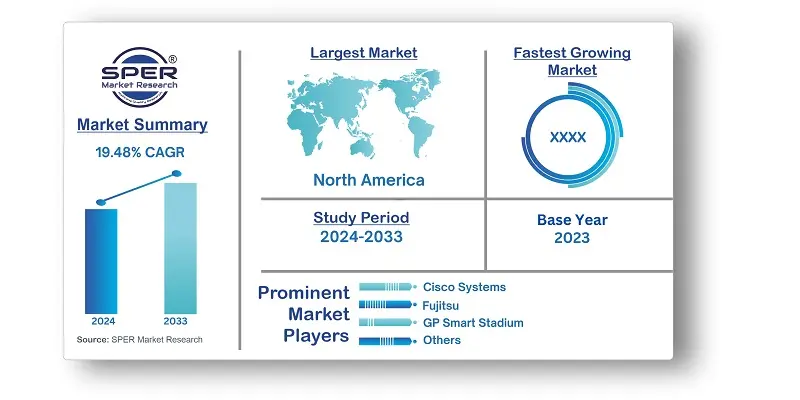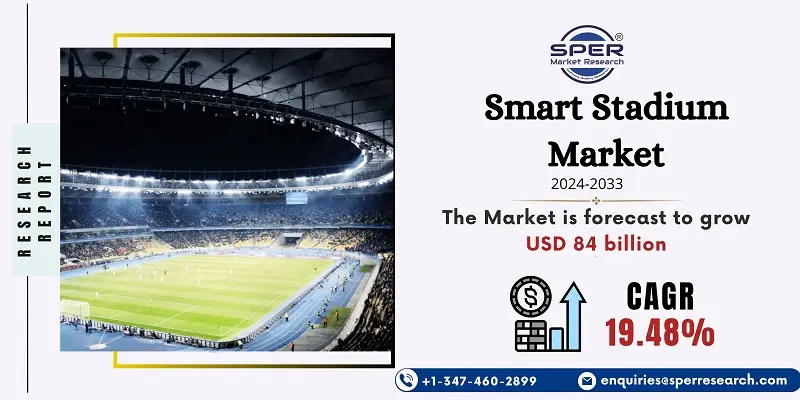
Smart Stadium Market Growth, Size, Trends, Demand, Revenue, Challenges and Future Outlook
Smart Stadium Market Size- By Solutions, By Services, By Deployment Type- Regional Outlook, Competitive Strategies and Segment Forecast to 2033
| Published: Apr-2024 | Report ID: IACT2475 | Pages: 1 - 210 | Formats*: |
| Category : Information & Communications Technology | |||
- Major League Baseball (MLB) team the San Diego Padres will be using Smart Stadium technology thanks to a partnership between JIG-SAW and Climatec that was formed in September 2023. Throughout the design, deployment, and service stages of JIG-SAW's IoT technology, Climatec will be a crucial component. It is anticipated that this technological adoption will lead to lower operating and maintenance expenses, longer equipment lifespans, and improved fan amenities for the Padres.
- Fujitsu and Eintracht joined together in February 2023 to develop environmentally friendly stadium management solutions that included AI integration, IoT-based sensor integration, and effective line management.
- Cisco Systems, Inc. and Manchester City have teamed together to put WaitTime's real-time crowd control software into use at the Etihad Stadium in December 2022.
- Santiago Bernabéu Stadium will host the development of Europe's top Wi-Fi 6 stadium network according to a multi-year global cooperation between Real Madrid and Cisco Systems, Inc. announced in November 2022. The goal is to rank the stadium as one of the world's most advanced sports venues.


| Report Metric | Details |
| Market size available for years | 2020-2033 |
| Base year considered | 2023 |
| Forecast period | 2024-2033 |
| Segments covered | By Solutions, By Services, By Deployment Type |
| Regions covered | North America, Asia-Pacific, Latin America, Middle East & Africa and Europe |
| Companies Covered | Cisco Systems, Inc, Fujitsu, GP Smart Stadium, Huawei Technologies Co, Ltd, IBM Corporation, Intel Corporation, Mapsted Corp, NEC Corporation, Johnson Controls, NXP Semiconductors, Schneider Electric, Tech Mahindra Limited, Telefonaktiebolaget LM Ericsson, Honeywell International Inc. |
- Stadium owners and operators
- Sport organizations
- Event organizers
- Technology providers
- Sponsors
- Broadcasters
| By Solutions: |
|
| By Services: |
|
| By Deployment Type: |
|
- Global Smart Stadium Market Size (FY’2024-FY’2033)
- Overview of Global Smart Stadium Market
- Segmentation of Global Smart Stadium Market By Solutions (Digital Content Management, Stadium and Public Security, Building Automation, Event Management, Network Management, Crowd Management)
- Segmentation of Global Smart Stadium Market By Services (Consulting, Deployment and Integration, Support and Maintenance)
- Segmentation of Global Smart Stadium Market By Deployment Type (On-premises, Cloud)
- Statistical Snap of Global Smart Stadium Market
- Expansion Analysis of Global Smart Stadium Market
- Problems and Obstacles in Global Smart Stadium Market
- Competitive Landscape in the Global Smart Stadium Market
- Impact of COVID-19 and Demonetization on Global Smart Stadium Market
- Details on Current Investment in Global Smart Stadium Market
- Competitive Analysis of Global Smart Stadium Market
- Prominent Players in the Global Smart Stadium Market
- SWOT Analysis of Global Smart Stadium Market
- Global Smart Stadium Market Future Outlook and Projections (FY’2024-FY’2033)
- Recommendations from Analyst
1.1. Scope of the report1.2. Market segment analysis
2.1. Research data source2.1.1. Secondary Data2.1.2. Primary Data2.1.3. SPER’s internal database2.1.4. Premium insight from KOL’s2.2. Market size estimation2.2.1. Top-down and Bottom-up approach2.3. Data triangulation
4.1. Driver, Restraint, Opportunity and Challenges analysis4.1.1. Drivers4.1.2. Restraints4.1.3. Opportunities4.1.4. Challenges4.2. COVID-19 Impacts of the Global Smart Stadium Market
5.1. SWOT Analysis5.1.1. Strengths5.1.2. Weaknesses5.1.3. Opportunities5.1.4. Threats5.2. PESTEL Analysis5.2.1. Political Landscape5.2.2. Economic Landscape5.2.3. Social Landscape5.2.4. Technological Landscape5.2.5. Environmental Landscape5.2.6. Legal Landscape5.3. PORTER’s Five Forces5.3.1. Bargaining power of suppliers5.3.2. Bargaining power of buyers5.3.3. Threat of Substitute5.3.4. Threat of new entrant5.3.5. Competitive rivalry5.4. Heat Map Analysis
6.1. Global Smart Stadium Market Manufacturing Base Distribution, Sales Area, Ingredients6.2. Mergers & Acquisitions, Partnerships, Product Launch, and Collaboration in Global Smart Stadium Market
7.1. Global Smart Stadium Market Size, Share and Forecast, By Solutions, 2020-20267.2. Global Smart Stadium Market Size, Share and Forecast, By Solutions, 2027-20337.3. Digital Content Management7.3.1. Audio and Video Management7.3.2. Digital Signage7.3.3. Mobile and Web Content Management7.4. Stadium and Public Security7.4.1. Access Control7.4.2. Video Surveillance7.4.3. PSIM7.4.4. Security Scanning, Imaging, and Metal Detection7.4.5. Emergency and Disaster Management7.4.6. Emergency and Disaster Management7.4.7. Others7.5. Building Automation7.5.1. Parking Management Systems7.5.2. Energy Management Systems7.5.3. Facility Management Systems7.6. Event Management7.6.1. Event Marketing and Registration7.6.2. Ticketing Management7.6.3. Workforce Management7.7. Network Management7.8. Crowd Management
8.1. Global Smart Stadium Market Size, Share and Forecast, By Services, 2020-20268.2. Global Smart Stadium Market Size, Share and Forecast, By Services, 2027-20338.3. Consulting8.4. Deployment and Integration8.5. Support and Maintenance
9.1. Global Smart Stadium Market Size, Share and Forecast, By Deployment Type, 2020-20269.2. Global Smart Stadium Market Size, Share and Forecast, By Deployment Type, 2027-20339.3. On-premise9.4. Cloud
11.1. Global Smart Stadium Market Size and Market Share
12.1. Global Smart Stadium Market Size and Market Share, By Region (2020-2026)12.2. Global Smart Stadium Market Size and Market Share, By Region (2027-2033)12.3. Asia-Pacific12.3.1. Australia12.3.2. China12.3.3. India12.3.4. Japan12.3.5. South Korea12.3.6. Rest of Asia-Pacific12.4. Europe12.4.1. France12.4.2. Germany12.4.3. Italy12.4.4. Spain12.4.5. United Kingdom12.4.6. Rest of Europe12.5. Middle East and Africa12.5.1. Kingdom of Saudi Arabia12.5.2. United Arab Emirates12.5.3. Qatar12.5.4. South Africa12.5.5. Egypt12.5.6. Morocco12.5.7. Nigeria12.5.8. Rest of Middle-East and Africa12.6. North America12.6.1. Canada12.6.2. Mexico12.6.3. United States12.7. Latin America12.7.1. Argentina12.7.2. Brazil12.7.3. Rest of Latin America
13.1. Cisco Systems, Inc.13.1.1. Company details13.1.2. Financial outlook13.1.3. Product summary13.1.4. Recent developments13.2. Fujitsu13.2.1. Company details13.2.2. Financial outlook13.2.3. Product summary13.2.4. Recent developments13.3. GP Smart Stadium13.3.1. Company details13.3.2. Financial outlook13.3.3. Product summary13.3.4. Recent developments13.4. Huawei Technologies Co., Ltd.13.4.1. Company details13.4.2. Financial outlook13.4.3. Product summary13.4.4. Recent developments13.5. IBM Corporation13.5.1. Company details13.5.2. Financial outlook13.5.3. Product summary13.5.4. Recent developments13.6. Intel Corporation13.6.1. Company details13.6.2. Financial outlook13.6.3. Product summary13.6.4. Recent developments13.7. Mapsted Corp.13.7.1. Company details13.7.2. Financial outlook13.7.3. Product summary13.7.4. Recent developments13.8. NEC Corporation13.8.1. Company details13.8.2. Financial outlook13.8.3. Product summary13.8.4. Recent developments13.9. Johnson Controls13.9.1. Company details13.9.2. Financial outlook13.9.3. Product summary13.9.4. Recent developments13.10. NXP Semiconductors13.10.1. Company details13.10.2. Financial outlook13.10.3. Product summary13.10.4. Recent developments13.11. Schneider Electric13.11.1. Company details13.11.2. Financial outlook13.11.3. Product summary13.11.4. Recent developments13.12. Tech Mahindra Limited13.12.1. Company details13.12.2. Financial outlook13.12.3. Product summary13.12.4. Recent developments13.13. Telefonaktiebolaget LM Ericsson13.13.1. Company details13.13.2. Financial outlook13.13.3. Product summary13.13.4. Recent developments13.14. Honeywell International Inc.13.14.1. Company details13.14.2. Financial outlook13.14.3. Product summary13.14.4. Recent developments13.15. Others
SPER Market Research’s methodology uses great emphasis on primary research to ensure that the market intelligence insights are up to date, reliable and accurate. Primary interviews are done with players involved in each phase of a supply chain to analyze the market forecasting. The secondary research method is used to help you fully understand how the future markets and the spending patterns look likes.
The report is based on in-depth qualitative and quantitative analysis of the Product Market. The quantitative analysis involves the application of various projection and sampling techniques. The qualitative analysis involves primary interviews, surveys, and vendor briefings. The data gathered as a result of these processes are validated through experts opinion. Our research methodology entails an ideal mixture of primary and secondary initiatives.



Frequently Asked Questions About This Report
PLACE AN ORDER
Year End Discount
Sample Report
Pre-Purchase Inquiry
NEED CUSTOMIZATION?
Request CustomizationCALL OR EMAIL US
100% Secure Payment






Related Reports
Our Global Clients
Our data-driven insights have influenced the strategy of 200+ reputed companies across the globe.






















